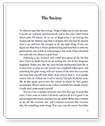Essay Instructions: Below is a copy of my topic proposal that was approved. This scholarly project is the final step needed before I graduate.The literature review needs to include all the information below. I am also the parent of a 9yr old boy with Asperger Syndrome so I have alot of personal experience.THIS WILL BE S A LITERATURE REVIEW ON THIS TOPIC.
TOPIC PROPOSAL:
Autism is a disorder of neural development characterized by impaired social interaction and communication, and by restricted and repetitive behavior. These signs all begin before a child is three years old. Autism affects information processing in the brain by altering how nerve cells and their synapses connect and organize. How or why this occurs is not well understood.
Asperger Syndrome is a classification for high functioning individuals on the autism spectrum that is characterized by the same significant difficulties in social relationships and restricted and repetitive patterns of behavior and interests, but to a far lesser degree than the more severe cases. It also differs from other autism spectrum disorders by its relative preservation of linguistic and cognitive development.
This independent study will be a literature review of information that has been written specifically to address characteristics and strategies geared towards individuals with Asperger Syndrome. Throughout the process of working toward my Masters in Special Education, I have found there is much information dealing with Autism and it's various disorders, but the literature is more limited when it comes to focusing on Asperger Syndrome. I have always felt that classic Autism is fairly easy to identify, but Asperger Syndrome is a more difficult disorder to pinpoint, especially in young children. Many behaviors can be quite subtle or mistaken for other disorders. Also, there are certain strategies and interventions that would be more appropriate for Asperger Syndrome alone as opposed to Autism.
I feel it is important for parents and professionals to have a comprehensive resource for Asperger's that stands out from the all inclusive Autism Spectrum Disorders resources presently available. By having a wealth of information located in one place, it will help others save time and get them started in the right direction. I anticipate that at the end of this project, I will have complied enough information to help guide people looking for answers to their questions about Asperger Syndrome.
ADDITIONAL INFORMATION ABOUT STRUCTURE OF PAPER: IT'S IMPORTANT THAT THE PAPER BE BROKEN INTO SECTIONS AS FOLLOWS. I HAVE INCLUDED SOME ADDITIONAL INFORMATION WITHIN THE GUIDELINES FOR PROJECT SECTION BELOW.
Chapter o1 is the Introduction.The literature review chapter 2 would concentrate on the characteristics of students with Asperger Syndrome, and the main project chapter 3 would concentrate on strategies for working with students with Asperger Syndrome. It would be a resource of strategies that teachers can use. Chapter 4 is the Summary/Conclusion/Recommendations and Reflective statement. There is more detsailed information below.
GUIDELINES FOR PROJECT FROM THE SCHOOL:
The following document is offered as a guide in the preparation of your final master’s project in fulfillment of the Master’s degree in Special Education. The following guidelines are presented to assist you in writing and assembling your project.
Acceptable style for the project should follow the most recent edition of the Publication Manual of the American Psychological Association. Formatting of title page, table of contents, margins, reference notes, lists, tables and general typing instructions should coincide with APA style. Equally as important is an appropriate professional style of writing. Please consult the APA manual or other writing style guides.
The following sections detail the appropriate contents of each section.
Chapter 1: Introduction (approximately 3-5 pages double-spaced)
Your introduction should provide the reader with a general introduction to the topic area. You should introduce the rationale for choosing the topic.. The introduction should provide the reader with a definitive statement of the problem under consideration and the potential benefit of the project. This chapter is an extension of the topic proposal you submitted to the Graduate School earlier.
Include the following in this section:
• General introduction of the topic area
• Statement of the Problem (why is this a topic worth exploring)
• Description of the Project
• Potential benefits of the project
Chapter 2: Review of the Literature (approximately 5-8 pages double spaced) This part of the project will consist of a literature review of characteristics of students with Asperger Syndrome.
The purpose of a literature review is to identify what is known and what is not known about your topic. To do this, you will need to locate seminal works (i.e., scholarly books, research articles, documents, reviews, internet resources) on your topic. The literature review must be defined by a guiding concept (e.g., your research objective, the problem or issue being addressed). The literature review connects theory with practice. It is not just a descriptive list of the material available or a set of summaries but an organized synthesis of what has been published on your topic by accredited scholars and researchers. The literature review should describe why your topic is an important one to explore and what has been discovered about your topic already. Depending on the topic, the number of sources for a literature review can range between five and fifteen (more is better).
Include the following in this section:
• Substantial review of recent literature pertinent to proposed topic organized into sections (e.g., use headings and subheadings)
Sources for the Literature Review
Academic Journals. Academic journals are usually the best source for literature reviews. These contain articles written by specialists in the field (usually college professors), who describe their research, secondary research, novel applications of existing theories, or interesting new ideas set in a theoretical context. There are several academic journals in the field of special education that can be accessed via an ERIC search.
The Internet. The internet is a good place to find a great deal of information quickly; however, this information is not always credible. While journal articles are peer-reviewed before being published, the only criterion for putting information on the internet is that one has a web site and the technical knowledge to post it. The U.S. Department of Education maintains the ERIC website which is designed specifically for educators at www.accesseric.org. ERIC stands for Educational Resources Information Center. This site contains thousands of journal articles, research reports, curriculum, conference papers, and teaching guides. The review process for many of these sources is minimal and thus, they vary widely in their validity and credibility.
Books. Books are also good sources, but keep in mind that just because information is written in a book does not mean it is always true. Books that cite their sources and those that are published by major publishing companies are generally those that can be trusted to provide credible information.
Chapter 3: Project (approximately 10-15 pages double-spaced) strategies for working with students with AS. Resource for teachers.
This chapter contains the actual project and the results of your project. Depending on the option chosen (e.g., Action Research Project, curriculum development project, in-service or workshop, or creation of an effective teaching strategy), this can be in chapter format or attached separately.
Chapter 4: Summary/Conclusions/Recommendations and Reflective Statement (approximately 3-5 pages)
This chapter provides the reader with a brief reiteration of the preceding three chapters. It should focus on integrating your project with what you found in the review of the literature.
This chapter must also include a reflective statement about both the project and your experience in the master’s program. This statement should include what you learned from doing the project, what you learned from or how you grew throughout your master’s program, what you see as the roles and responsibilities of a special education teacher, and finally, your definition of and plans for professional development. I UNDERSTAND THAT I MAY NEED TO ADD MY OWN THOUGHTS TO THIS SECTION WHEN I RECEVIE THE PAPER. AGAIN, I AM A PARENT OF A CHILD WITH ASPERGER SYNDROME SO THIS IS A VERY PERSONAL TOPIC AS WELL AS AN EDUCATIONAL ONE. I AM CURRENTLY A KINDERGARTEN TEACHER AND THIS PROJECT WILL COMPLETE MY MASTERS IN SPECIAL EDUCATION WITH A MAJOR CONCENTRATION IN AUTISM SPECTRUM DISORDERS.
Include the following in this section (use the following as your headings):
• A summary including the significance of your project in relation to the literature
• Conclusions/results of your project
• Recommendations or changes to you would have made or will make as a result of doing your project
• Reflective statement that addresses the four areas listed above.
Reference List:
You should provide a complete reference list of all materials used in the study, as well as any references cited in your literature review. The format should follow APA guidelines as established in the manual.
The Final Copy:
A bound copy of the project should be made for the advisor to keep for University record keeping. The binding is of your choosing and can be as simple as a plastic folder that you can purchase at several places (e.g., Target, Walmart) or as elaborate as a spiral binding at Kinko's or a similar store that does binding. Do not use a three ring binder unless it has soft sides.
IF I COULD HAVE THE PAPER E-MAILED AS WELL IT WOULD BE EXTREMELY APPRECIATED. IF YOU FEEL THIS IS TOO SPECIFIC A PROJECT AND IT WOULD NOT BE ABLE TO BE DONE EXACTLY THE WAY NEEDED, PLEASE LET ME KNOW AS SOON AS POSSIBLE. I CAN ALSO ONLY DO THIS IF IT IS 100% GUARENTEED THAT EVERYTHING IS KEPT COMPLETELY CONFIDENTIAL. I KNOW YOU MUST HEAR THAT ALOT, BUT I NEED TO BE CERTAIN.


